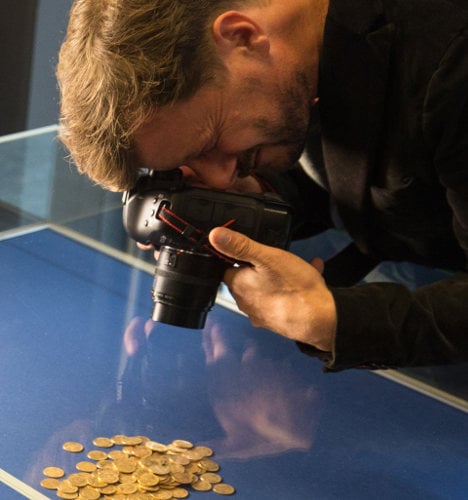Amateur archaeologist finds Nazi gold hoard

A man in northern Germany has found a €45,000 hoard of Nazi gold – but will only pocket a small portion of the sum.
The dream of every treasure-hunter came true for Florian Bautsch last October when he found 217 Nazi-era gold coins in Lüneburg, the Süddeutsche Zeitung (SZ) reported on Tuesday.
Bausch – a certified metal detectorist – was exploring old burial mounds in the town south of Hamburg when he stumbled across the first gold piece.
After a further search under the foliage uncovered nine more coins, Bautsch did a survey of the area and got in touch with local archaeologists.
A two-week long excavation followed, unearthing a further 207 gold coins – with a material worth estimated at around €45,000.
Archaeologists also found remnants of pasteboard with two seals bearing the swastika, imperial eagle and the stamp: "Reichsbank Berlin 244".
The find was exhibited in Lüneburg Museum on Tuesday – and caused considerable excitement among experts, according to Lüneburg archaeologist Edgar Ring.

Despite the value of the coins coming to €45,000, Bautsch is only set to receive the relatively small sum of €2,500 as his finder's reward – but explained his honesty by saying that the most important thing for him was furthering scientific knowledge.
'A stroke of luck'
Although similar finds have been made in the past, almost all have lacked archaeological context, with illegal metal detectorists often destroying crucial clues as to the coins' origin.
The fact this find was made by someone so well-informed was a stroke of luck, Lower Saxony state archaeologist Henning Haßmann told the SZ.
It means the trove can be dated back to the time period immediately after the Second World War.
The coins had originally been placed in two separate pouches, of which only the seals now remain.
They were buried under about a metre of earth, around the foot of a tree – but were scattered around the area when the tree was later uprooted.
Of the coins, 128 bore Belgian stamps, while 74 originated in France and 12 from Italy. The final three bore Austro-Hungarian stamps.
All have a diameter of 21mm and weigh 6.45 grams, with an overall weight of 1.4kg, and most were minted between 1850 and 1910 – with the oldest dating back to 1831.
Chemical analysis of the pasteboard remains and seals showed that the coins were likely packaged up sometime between 1940 and 1950.
Ring said that he was certain the gold had belonged to the Nazi-era Reichsbank (central bank) and was a collection of stolen coins.
According to Haßmann, the coins would have been produced as limited editions, to be used as investment pieces for banks and private investors.
Comments
See Also
The dream of every treasure-hunter came true for Florian Bautsch last October when he found 217 Nazi-era gold coins in Lüneburg, the Süddeutsche Zeitung (SZ) reported on Tuesday.
Bausch – a certified metal detectorist – was exploring old burial mounds in the town south of Hamburg when he stumbled across the first gold piece.
After a further search under the foliage uncovered nine more coins, Bautsch did a survey of the area and got in touch with local archaeologists.
A two-week long excavation followed, unearthing a further 207 gold coins – with a material worth estimated at around €45,000.
Archaeologists also found remnants of pasteboard with two seals bearing the swastika, imperial eagle and the stamp: "Reichsbank Berlin 244".
The find was exhibited in Lüneburg Museum on Tuesday – and caused considerable excitement among experts, according to Lüneburg archaeologist Edgar Ring.

Despite the value of the coins coming to €45,000, Bautsch is only set to receive the relatively small sum of €2,500 as his finder's reward – but explained his honesty by saying that the most important thing for him was furthering scientific knowledge.
'A stroke of luck'
Although similar finds have been made in the past, almost all have lacked archaeological context, with illegal metal detectorists often destroying crucial clues as to the coins' origin.
The fact this find was made by someone so well-informed was a stroke of luck, Lower Saxony state archaeologist Henning Haßmann told the SZ.
It means the trove can be dated back to the time period immediately after the Second World War.
The coins had originally been placed in two separate pouches, of which only the seals now remain.
They were buried under about a metre of earth, around the foot of a tree – but were scattered around the area when the tree was later uprooted.
Of the coins, 128 bore Belgian stamps, while 74 originated in France and 12 from Italy. The final three bore Austro-Hungarian stamps.
All have a diameter of 21mm and weigh 6.45 grams, with an overall weight of 1.4kg, and most were minted between 1850 and 1910 – with the oldest dating back to 1831.
Chemical analysis of the pasteboard remains and seals showed that the coins were likely packaged up sometime between 1940 and 1950.
Ring said that he was certain the gold had belonged to the Nazi-era Reichsbank (central bank) and was a collection of stolen coins.
According to Haßmann, the coins would have been produced as limited editions, to be used as investment pieces for banks and private investors.
Join the conversation in our comments section below. Share your own views and experience and if you have a question or suggestion for our journalists then email us at [email protected].
Please keep comments civil, constructive and on topic – and make sure to read our terms of use before getting involved.
Please log in here to leave a comment.